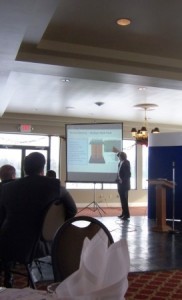
CLEARFIELD – Residents in Pennsylvania have been hearing for the last few years about what a boon Marcellus Shale gas mining will be to their areas. On Thursday, members of the Clearfield County Economic Development Corporation heard from a natural gas expert on the potential boom. David J. Spigelmyer also worked to demystify some of the hot topics concerning natural gas mining.
Spigelmyer is the vice-president of government relations for Chesapeake Energy. He has spent 28 years in the natural gas industry.
“This is a game-changer for Pennsylvania,” said Spigelmyer. He added that companies are drilling into solid rock, not open caverns. He also said that without the fracturing process, the gas extraction would never occur. He also noted that fracturing is used in all oil and gas drilling/mining.
Spigelmyer said that the Marcellus Shale play has the potential to cut the ‘demand’ part of a natural gas bill in half. He added taht within four years, Pennsylvania will be able to exceed producing 810 cubic feet of natural gas per year. For Pennsylvania to reach that point, pipelines will be needed to more effectively transport that gas.
“Longhaul pipeline is not available yet in Pennsylvania,” he added.
“We have an unquenchable appetite for energy,” said Spigelmyer. “Solar cells and windmills won’t cover.”
He stated that Clearfield County is number seven on the state’s permit list for planned mining activity. He also added that the mining can be done in a “very conservative-minded approach.”
One topic touched on was free-flowing methane, something mining companies tested for in the past but were not required to share their information on with landowners. Spigelmyer said that free-flowing methan is fairly prevalent in Pennsylvania; he used the example of a pond in which you see bubbles occassionally burst on the surface. The bubbles are most likely methane bubbles. He said one of the biggest problems in Pennsylvania is that homeowners sometimes have wells directly underneath their homes. He said this would not be a problem, accept the wells are not ventilated. He said his company spends a lot of time helping residents in mining areas remmediate that problem.
Those gathered were shown a video on the mining process. Afterward, Spigelmyer touched on fracking. He said 99.5 percent of the fluid is water and sand, and the other .5 percent is made up of chemicals. He said the sand and water are the main components in the fracturing process; they are pumped down casings in the ground, where the pressurized water causes weak areas the ground to fracture. The sand in the mixture goes into these fractures and lodges within, holding them open. Spigelmyer said the chemicals in the solution are used to kill bacteria, scale on the metal pipes and to clean the cement casings.
“There’s a lot of hysteria over hydrofracturing,” said Spigelmyer. “We’ve done it safely everywhere we’ve gone.”